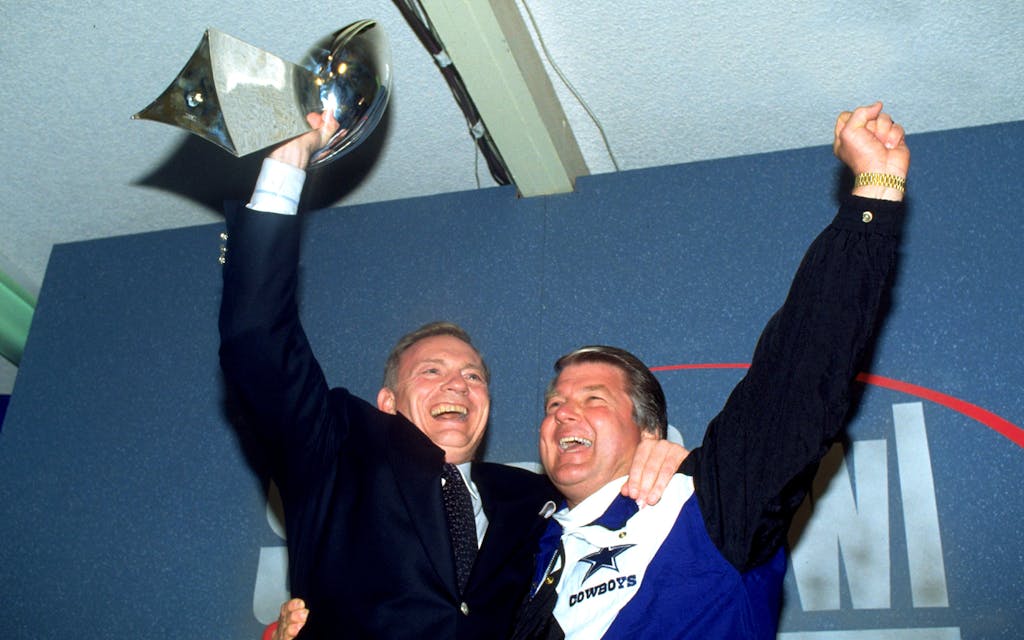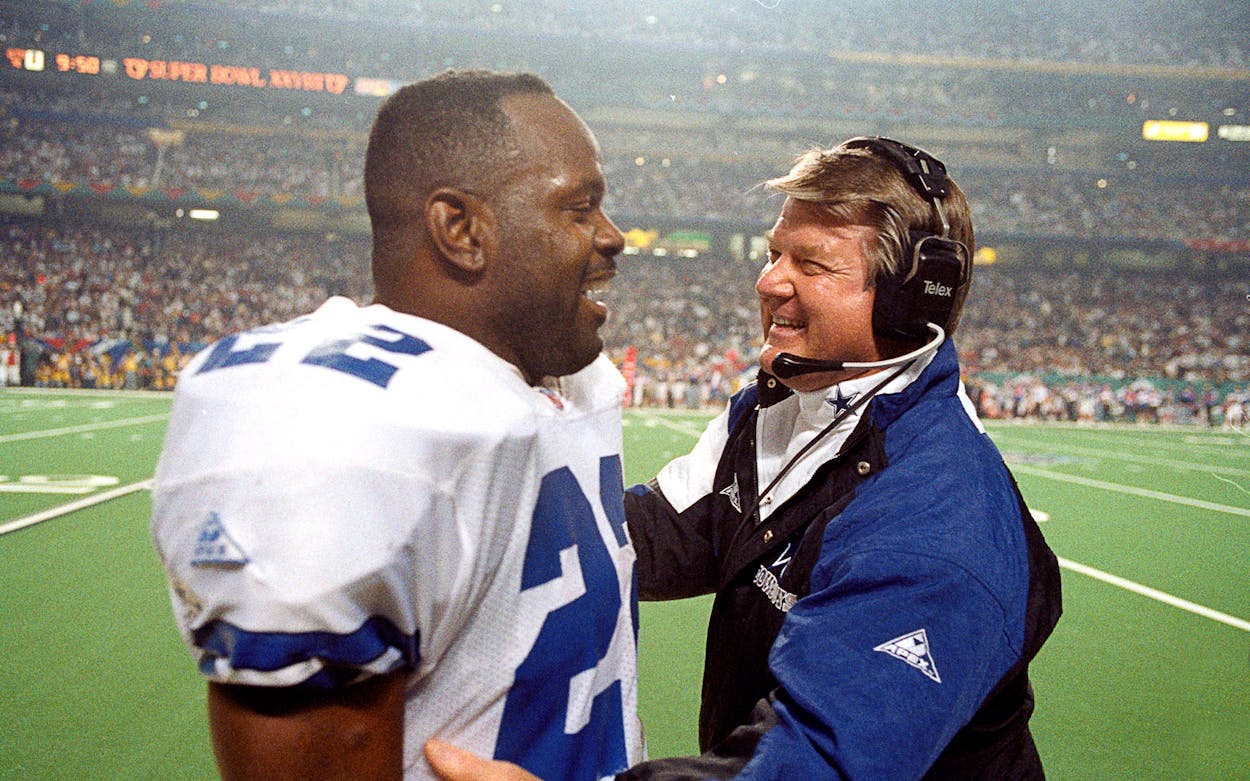The Dallas Cowboys had just beaten the Minnesota Vikings by seventeen points on the road late in the 1993 season. In the NFL, this qualified as a good day at the office.
That was especially true for the defending Super Bowl champions, who’d overcome the standard title hangover cocktail of contract disputes, injuries, and bad luck to put themselves in position to win a second championship.
In the moment, only Cowboys coach Jimmy Johnson wasn’t happy. His defense had allowed the Vikings to breeze down the field for a late score, and in the locker room afterward, Johnson went ballistic. “It was brutal,” remembered Norv Turner, Johnson’s offensive coordinator in Dallas from 1991 through ’93. “You should never be unhappy when you win a game.
“At the same time,” Turner explained in a conversation with Texas Monthly, “Jimmy hated that we had control of the game and let them score so easily. He was furious we hadn’t just locked it down.”
That is one of many stories sure to come up this weekend, as dozens of Johnson’s players, coaches, and friends gather in Canton, Ohio, for Johnson’s induction Saturday into the Pro Football Hall of Fame. For Cowboys fans, it’ll be a reminder of how things used to be—when America’s Team won three Super Bowls in four seasons in the mid-nineties. Johnson coached only two of those squads, but his draft choices, trades, and organizational structure positioned the Cowboys to win Super Bowl XXX under head coach Barry Switzer in 1996.
These days, memories, to quote Ricky Nelson, are all Dallas fans have. In the last 25 seasons, the Cowboys have won a grand total of four playoff games and haven’t come close to another NFC championship game, much less a Super Bowl. But this week in Canton, they’ll get the band back together. Hall of Famers Troy Aikman, Emmitt Smith, and Michael Irvin will be there, having been previously enshrined. So will the assistant coaches, trainers, and an assortment of other ex-Cowboys who helped bring those trophies to Dallas.
Another story they’re likely to tell is what happened at halftime of Super Bowl XXVIII in Atlanta, which was one of Johnson’s finest hours. The Cowboys trailed 13–6, and far from the fury he exhibited after the Vikings game weeks earlier, Johnson couldn’t have been more calm. He told the players to catch their breath while the coaches worked out a plan to counter Buffalo’s defense.
“In about ten minutes, let’s get back together, we’ll have everything up on the board for you,” Johnson said, as recounted by fullback Daryl Johnston in an oral history of the coach’s career published at the Athletic. “We’re going to show you what they’re doing. We’re going to show you how we’re going to counter that. And the second half, we’re going to force them out of what they’re doing right now. And then as soon as they move out of that we can get back to what we planned on doing.”
“I’ve always felt the way that Jimmy handled that whole thing [was] because we were really frustrated coming in at halftime,” Johnston added. “I thought it was, if not his best coaching moment while we were there, it was definitely near the top.”
Cowboys owner Jerry Jones, a 2017 Hall of Fame inductee, will also join the party in Canton. It was his genius to hire Johnson to replace Tom Landry shortly after purchasing the team in 1989, and his worst mistake to fire him five years later.
“I (bleeped) it up,” Jones told reporters recently, his first time admitting what every Cowboys fan—and dang near every football fan—already knew. (To be fair, both men deserve some blame for being unable to overcome the jealousies and pettiness they took out on each other, and for their inability to understand how good they were for each other.)

That’s the bittersweet part of the story. Aikman, who will introduce Johnson at Saturday’s ceremony, has said those teams should have won five Super Bowls—if only their coach and franchise owner could have gotten along. That’s unlikely to detract from a week in which Johnson and Tom Flores will be the twenty-seventh and twenty-eighth head coaches to receive the game’s highest honor.
That’s not how a lot of Cowboys fans thought things would play out when Jones bought the team and unceremoniously fired the beloved Mount Landry. Some vowed never to watch America’s Team again. It wasn’t just that Jones got rid of Landry. It was that he replaced him with a cocky, blow-dried college coach who seemed, at first glance, supremely unqualified for the NFL.
Johnson’s genius would reveal itself in the years ahead. He drafted brilliantly, made a string of savvy trades, and hired one of the NFL’s best coaching staffs. “He was decisive,” Turner said. “He could identify talent, but a lot of people can do that. What Jimmy did was identify talent with an idea how that talent would fit onto his team.”
He trusted his eye for talent, but when Johnson made a personnel mistake, he was fast to admit the error and cut the player. “You don’t want to come in every day and be reminded of a mistake,” he once said.
Turner remembered that Johnson was cautioned to stay away from veteran pass-rusher Charles Haley in 1992, when the San Francisco 49ers made him available. Instead, Johnson asked, “He’s a smart guy, right?” One of the smartest, Johnson was told, but Haley, supposedly, was trouble in the locker room. Johnson believed he could appeal to Haley’s reason and persuade him to buy in to the Cowboys locker room.
He was right. Dallas traded for Haley and the 2015 Hall of Fame inductee was a force on all three Cowboys championship teams.
Irvin was an unproven second-year wide receiver with a questionable attitude when Johnson arrived in Dallas in the spring of 1989. But Johnson had been Irvin’s coach at the University of Miami and knew the player had a burning desire to be great—and wealthy.
In 1991, when Irvin got into a fight at a charity basketball game, Johnson got the message through to his player that such public controversies would ruin his chances of scoring endorsement deals. Irvin also was believed to have spit on Washington’s All-Pro cornerback Darrell Green during a game the previous year. Whether that actually happened is in dispute. What isn’t in dispute is that Irving was told: “Michael, do you think players are going to vote you into the Pro Bowl if you do that to one of the league’s best players?”
Virtually every coach and player of the Johnson era has a recollection of some moment with Johnson that they remember to this day. Once, after a loss in Washington, he stormed through the team plane looking for a confrontation. He found one in Frank Cornish, the Cowboys’ nearly three-hundred-pound center, who Johnson believed was not taking the loss seriously enough. “What the f— is so funny, Frank?” Johnson said. “We just got our asses kicked and you’re laughing?”
Away from the heat of competition, though, Johnson could bend over backward to help out Cowboys players and coaches. A born-and-raised Texan who attended Port Arthur’s Thomas Jefferson High School at the same time as Janis Joplin, he understood how to treat people right—and how to charm them. This is the NFL head coach who installed a satellite dish in defensive coordinator Dave Wannstedt’s house. He stuffed wads of bills in the pockets of assistant coaches during trips to the horse track. He persuaded Aikman to purchase an aquarium, then helped him stock and maintain it. Aikman told the Athletic that Johnson and his then-girlfriend Rhonda (the couple is now married) would randomly drop in on the quarterback’s home to drink beer and chat. In the end, the aquarium seemed to be a vehicle for building a relationship.
Turner got that treatment after he joined the Cowboys in 1991. When Johnson would show up at the team’s practice facility and see his new offensive coordinator studying game tape, Johnson would drag Turner out of the video room and take him out for Tex-Mex or to a sports bar. Those queso runs planted the seeds of a relationship that is now in its fourth decade.
There were days when some players and coaches thought Johnson faked a temper tantrum or two for effect. Other times, he scared the hell out of people.
“You’re damn right,” Turner told me. He remembered the week Johnson had been so unhappy with the team’s effort and execution at practice that he spent three days chewing out virtually every coach, player, trainer, and equipment manager who crossed his path.
“That week we win on a tipped ball,” Turner remembered. “Now, did we get that tipped ball because Jimmy had been on our asses all week?”
I told Turner that’s the mark of a great coach. Johnson recognized that his team lacked an edge, and his response helped the Cowboys send an angry team onto the field that Sunday instead of a passive one. That’s the difference between winning and losing. After we finished our chat, Turner called back a few hours later after thinking about all the things that made Jimmy Johnson successful. “He had a great feel for his team,” Turner said. “He also knew different players were motivated by different things, and he pushed those buttons.”
I wondered how Johnson, who arrived in Dallas with zero NFL experience, could have been so good at a job that was so different from his head-coaching gigs at Oklahoma State and Miami. “I think he learned how to be a head coach,” Turner said. “He coached the whole team, not the offense or defense. But if you watched him during a game week, he was involved in all of it, especially special teams. He had a feel for what was going to allow us to be successful in different situations.”
Turner was at the center of another of Johnson’s finest hours, as well as the iconic moment that followed. In the 1992 season NFC championship game at Candlestick Park—the one that propelled Johnson to his first Super Bowl—the 49ers had just scored to cut Dallas’s lead to 24–20 with 4:22 left in the fourth quarter. When the Cowboys started their next offensive drive, Johnson’s instruction for Turner was simple: “Attack.” Turner did just that, and on the first play—with the 49ers and the world anticipating a run—Aikman sealed the game with an eighty-yard touchdown pass to Alvin Harper.
No small amount of lore has grown around that play. Did Johnson really walk the field at Candlestick before the game to find potential slippery spots? Is that what won the game? After the victory, the legend of Jimmy Johnson was born, once and for all, when he hopped onto an equipment crate and congratulated his players while reminding them not to lose focus on the upcoming Super Bowl.
Then, sensing something more upbeat was needed, he shouted: “How ’bout them Cowboys?”
Those words have rung in Johnson’s ears every day since. Fans still shout it. Players smile about it. This week in Canton, as they share drinks and dinners and memories, it’ll come up a time or two.
“Some of these players haven’t had a chance to tell Jimmy what he meant to them,” Aikman said last month. “What we benefited from, it was because of Jimmy Johnson.”






